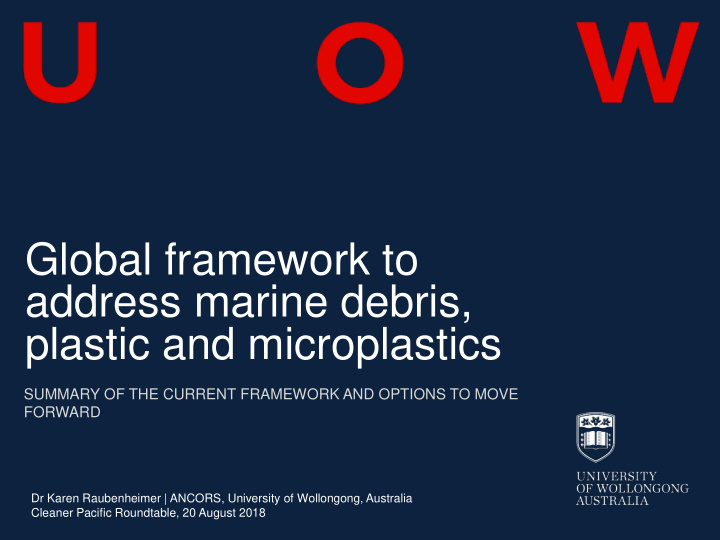



Global framework to address marine debris, plastic and microplastics SUMMARY OF THE CURRENT FRAMEWORK AND OPTIONS TO MOVE FORWARD Dr Karen Raubenheimer | ANCORS, University of Wollongong, Australia Cleaner Pacific Roundtable, 20 August 2018
Relevant global binding agreements UN Law of the Sea Convention Biodiversit Chemicals Pollution y & Waste & Species 18 international instruments 36 regional instruments Combating marine plastic litter and microplastics: An assessment of the effectiveness of relevant international, regional and subregional governance strategies and approaches (UNEP/EA.3/INF/5) IDENTIFY
Overview: international & regional instruments IDENTIFY
Regional instruments – current status IDENTIFY
Gaps in the current framework INTERNATIONAL & REGIONAL INTERNATIONAL REGIONAL SEAS Scope of application Geographic gaps • UNCLOS addresses activities • 14/18 have adopted a legal resulting directly/indirectly to framework plastics entering the marine (one not in force) environment • 9 of these have adopted LBS/A • From land, sea and air Protocols (four not in force) • Not all States are party to the relevant convention or protocol Definitions • Most will cover plastic Limitations in mandate pollution, but limited within • Protection of human health full lifecycle (chemicals) • Upstream activities HUMAN HEALTH, MICROPLASTICS, CHEMICALS IDENTIFY
What is the end goal? TOWARDS A CIRCULAR ECONOMY Recoverable - collect - identify - separate Reusable - original use - other sectors Recyclable - mechanical - chemical Eliminate People’s Design Lab INNOVATE
The reality? BARRIERS TO THE CIRCULAR ECONOMY Only 70% of the U.S. waste stream can be recycled or composted * EU plastics recycling strategy • 2030 – all plastics packaging to be recyclable • 2030 – 55 % all plastics waste generated in Europe to be recycled * BEYOND 34 CASE STUDY: THE DEVELOPMENT OF A RECYCLING PUBLIC- INNOVATE PRIVATE PARTNERSHIP, Sara Zellner, Ph.D. Consultant to the U.S. Chamber of Commerce Foundation
Tackling the issue DECONSTRUCT THE PROBLEM 1) Unnecessary/problematic applications and materials • Aim to reduce, eliminate • Alternate materials 2) Necessary short- and medium-term applications • Aim to manage 3) Long-term applications • May have legacy issues • How to manage in waste stream 4) Non-recyclable applications and materials • Mechanical recycling into houses, roads, etc. • Waste-to-Energy (with care) 5) Microplastics • Aim to reduce, eliminate primary • Prevent secondary thru design, regulation, lifecycle assessment INNOVATE
EPR for packaging in Norway New amendment to waste regulation - Must join approved compliance scheme (traditional) - If supply market with min. 1,000kg packaging type / year - Finance the collection, sorting, recycling & other processing of waste packaging - May only place packaging on Norwegian market if: - Complies with Annex I (Design, reuse, recycling requirements) - % can be recycled into marketable products in compliance with community standards - Must prevent waste & report - Report % change in packaging onto market & decrease in waste generated from previous years INNOVATE
Creating end-markets SUPPORTING THE CIRCULAR ECONOMY Creating supply Creating demand Landfill taxes/bans Procurement policies - increase diversion - % recycled content - international trade - Government Licence fees Recycling targets - not recyclable - incentivise collection - no recycled content - investment IMPLEMENT
Making it a reality POSSIBILITIES AS A REGION Harmonised national measures - Regulate manufacture, import & sale of single use plastic products - Bans, recycled content, recyclability - Prohibit microplastics in personal care products - Collection - Container deposit schemes - Reverse logistics - Raising funds - Non-Pacific visitor environmental levy - Environment fund based on levies/fees/charges: - Visitor levy, license fees for plastics manufacturers, importers, retailers - e.g. Taiwan EPA fund - http://recycle.epa.gov.tw/ IMPLEMENT
Broadening the scope NOT JUST MARINE ECOSYSTEMS SDGS – beyond 14.1 • 2.1 : access to safe food • 3.9 : hazardous chemicals • 6.3 : water quality, wastewater (MP) • 8.4 : consumption & production • 11.6 : air quality, MSW • 12.4 : lifecycle of chemicals, all waste • 12.5 : reduce waste generation • 14.1 : marine pollution • 14.2 : marine restoration • 15.5 : biodiversity • 17.6 : cooperation, knowledge sharing • 17.9 : capacity building • 17.16: support SDG achievement IMPLEMENT Image: Azote-Images-for-Stockholm-Resilience-Centre
Thank you
Recommend
More recommend